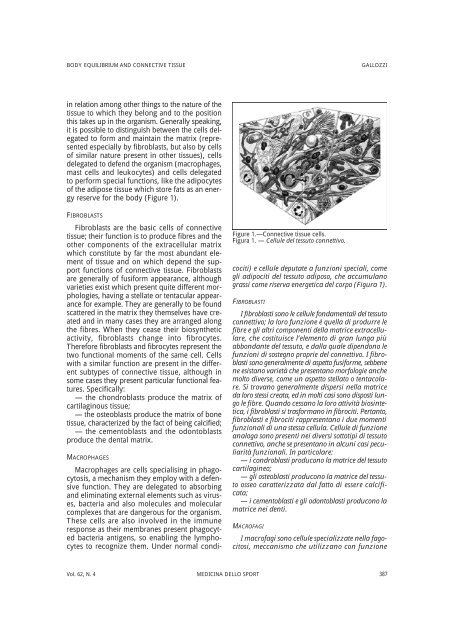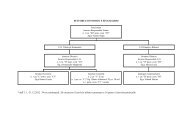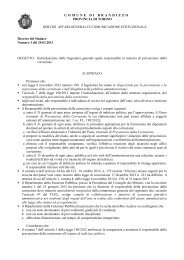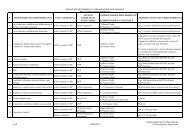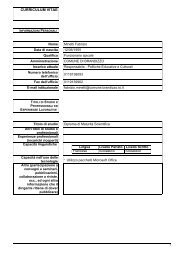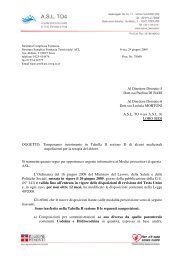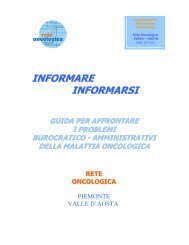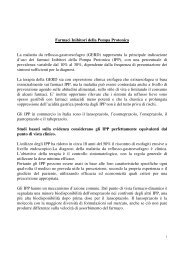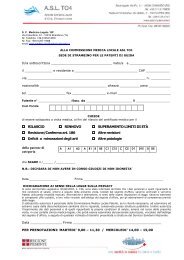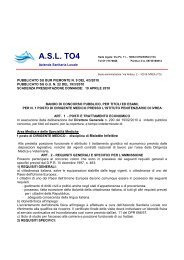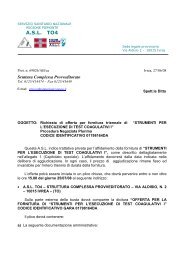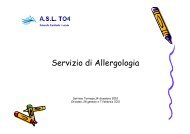Articolo sulla casistica delle non idoneità allo sport agonistico in ...
Articolo sulla casistica delle non idoneità allo sport agonistico in ...
Articolo sulla casistica delle non idoneità allo sport agonistico in ...
You also want an ePaper? Increase the reach of your titles
YUMPU automatically turns print PDFs into web optimized ePapers that Google loves.
BODY EQUILIBRIUM AND CONNECTIVE TISSUE GALLOZZI<br />
<strong>in</strong> relation among other th<strong>in</strong>gs to the nature of the<br />
tissue to which they belong and to the position<br />
this takes up <strong>in</strong> the organism. Generally speak<strong>in</strong>g,<br />
it is possible to dist<strong>in</strong>guish between the cells delegated<br />
to form and ma<strong>in</strong>ta<strong>in</strong> the matrix (represented<br />
especially by fibroblasts, but also by cells<br />
of similar nature present <strong>in</strong> other tissues), cells<br />
delegated to defend the organism (macrophages,<br />
mast cells and leukocytes) and cells delegated<br />
to perform special functions, like the adipocytes<br />
of the adipose tissue which store fats as an energy<br />
reserve for the body (Figure 1).<br />
FIBROBLASTS<br />
Fibroblasts are the basic cells of connective<br />
tissue; their function is to produce fibres and the<br />
other components of the extracellular matrix<br />
which constitute by far the most abundant element<br />
of tissue and on which depend the support<br />
functions of connective tissue. Fibroblasts<br />
are generally of fusiform appearance, although<br />
varieties exist which present quite different morphologies,<br />
hav<strong>in</strong>g a stellate or tentacular appearance<br />
for example. They are generally to be found<br />
scattered <strong>in</strong> the matrix they themselves have created<br />
and <strong>in</strong> many cases they are arranged along<br />
the fibres. When they cease their biosynthetic<br />
activity, fibroblasts change <strong>in</strong>to fibrocytes.<br />
Therefore fibroblasts and fibrocytes represent the<br />
two functional moments of the same cell. Cells<br />
with a similar function are present <strong>in</strong> the different<br />
subtypes of connective tissue, although <strong>in</strong><br />
some cases they present particular functional features.<br />
Specifically:<br />
— the chondroblasts produce the matrix of<br />
cartilag<strong>in</strong>ous tissue;<br />
— the osteoblasts produce the matrix of bone<br />
tissue, characterized by the fact of be<strong>in</strong>g calcified;<br />
— the cementoblasts and the odontoblasts<br />
produce the dental matrix.<br />
MACROPHAGES<br />
Macrophages are cells specialis<strong>in</strong>g <strong>in</strong> phagocytosis,<br />
a mechanism they employ with a defensive<br />
function. They are delegated to absorb<strong>in</strong>g<br />
and elim<strong>in</strong>at<strong>in</strong>g external elements such as viruses,<br />
bacteria and also molecules and molecular<br />
complexes that are dangerous for the organism.<br />
These cells are also <strong>in</strong>volved <strong>in</strong> the immune<br />
response as their membranes present phagocyted<br />
bacteria antigens, so enabl<strong>in</strong>g the lymphocytes<br />
to recognize them. Under normal condi-<br />
Figure 1.—Connective tissue cells.<br />
Figura 1. — Cellule del tessuto connettivo.<br />
cociti) e cellule deputate a funzioni speciali, come<br />
gli adipociti del tessuto adiposo, che accumulano<br />
grassi come riserva energetica del corpo (Figura 1).<br />
FIBROBLASTI<br />
I fibroblasti sono le cellule fondamentali del tessuto<br />
connettivo; la loro funzione è quella di produrre le<br />
fibre e gli altri componenti della matrice extracellulare,<br />
che costituisce l’elemento di gran lunga più<br />
abbondante del tessuto, e dalla quale dipendono le<br />
funzioni di sostegno proprie del connettivo. I fibroblasti<br />
sono generalmente di aspetto fusiforme, sebbene<br />
ne esistano varietà che presentano morfologie anche<br />
molto diverse, come un aspetto stellato o tentacolare.<br />
Si trovano generalmente dispersi nella matrice<br />
da loro stessi creata, ed <strong>in</strong> molti casi sono disposti lungo<br />
le fibre. Quando cessano la loro attività bios<strong>in</strong>tetica,<br />
i fibroblasti si trasformano <strong>in</strong> fibrociti. Pertanto,<br />
fibroblasti e fibrociti rappresentano i due momenti<br />
funzionali di una stessa cellula. Cellule di funzione<br />
analoga sono presenti nei diversi sottotipi di tessuto<br />
connettivo, anche se presentano <strong>in</strong> alcuni casi peculiarità<br />
funzionali. In particolare:<br />
— i condroblasti producono la matrice del tessuto<br />
cartilag<strong>in</strong>eo;<br />
— gli osteoblasti producono la matrice del tessuto<br />
osseo caratterizzata dal fatto di essere calcificata;<br />
— i cementoblasti e gli odontoblasti producono la<br />
matrice nei denti.<br />
MACROFAGI<br />
I macrofagi sono cellule specializzate nella fagocitosi,<br />
meccanismo che utilizzano con funzione<br />
Vol. 62, N. 4 MEDICINA DELLO SPORT 387


